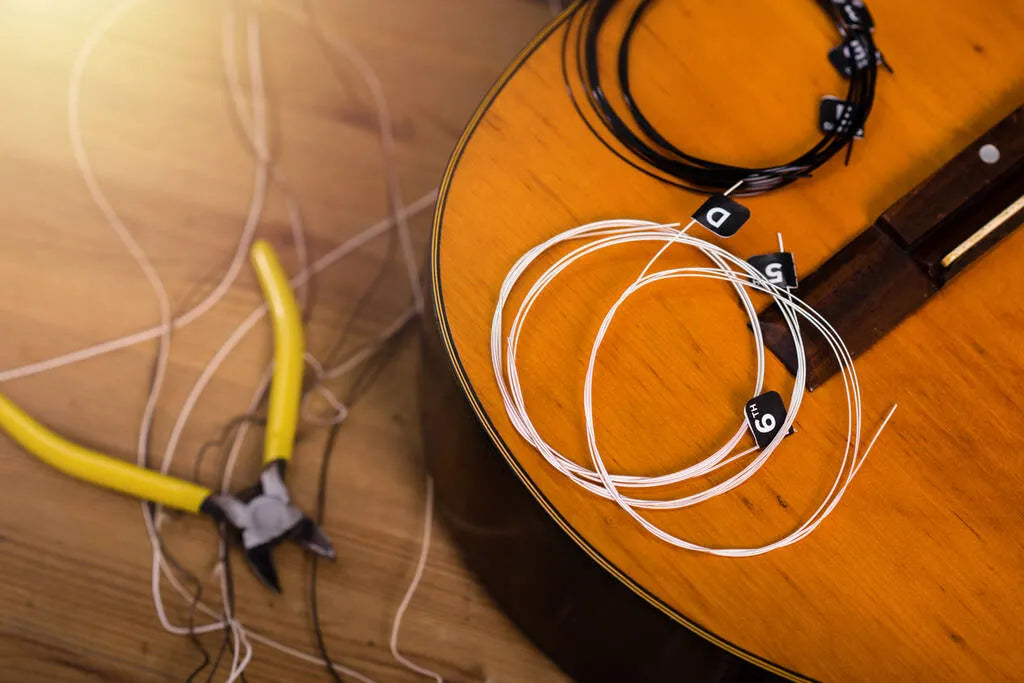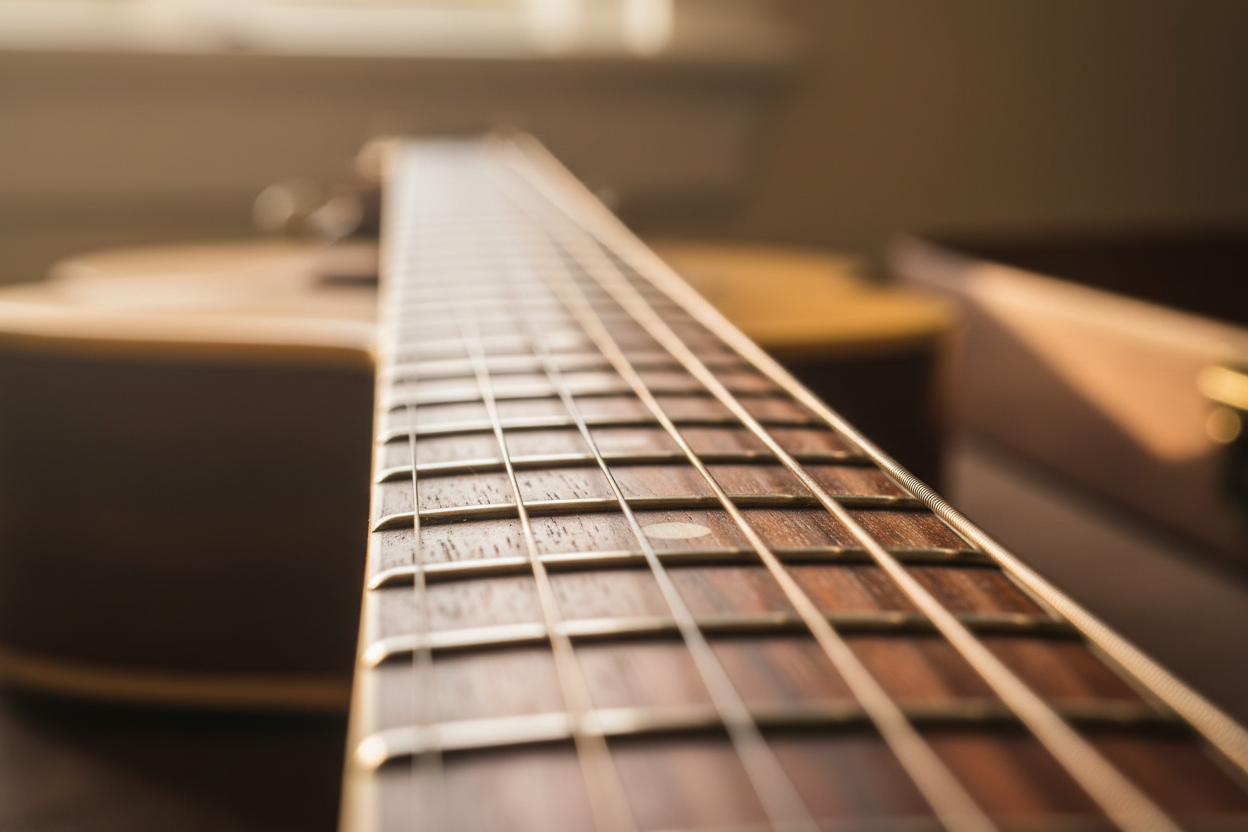Your guitar is not merely an instrument but a vital component of your creative expression. Maintaining its optimum condition is essential to achieve excellent sound quality and smooth performance. Regular care and swift identification and rectification of potential issues are the cornerstones of preserving your guitar's integrity. However, recognizing these problems might be challenging if you're not familiar with your instrument's intricacies.
Here are several signs that may indicate your guitar is due for servicing:
- Inaccurate Intonation: If your guitar fails to remain in tune across the neck, even when open-tuned, it may point to underlying intonation issues. These issues can be resolved by adjusting the intonation screws located at the saddles.
- Buzzing Strings: Should you notice buzzing sounds during play, it could signal issues like excessively low action, uneven frets, or a need for truss rod adjustment.
- Structural Damage or Cracks: Failure to store your guitar properly or control humidity levels can result in structural damage, including cracks and wood separations. These damages, though often subtle at the onset, can dramatically affect your guitar's tonal quality and eventually lead to costly repair needs. Hence, it's essential to conduct regular, detailed inspections of your guitar, particularly keeping an eye out for signs of separating joints.
- High Action: Difficulty in pressing down the strings due to their high placement from the fretboard suggests high action; this issue can be fixed by adjusting the saddle.
- Electronics Issues: If you're experiencing buzzing, humming, or sound interruptions while playing your electric guitar, it may be caused by faulty wiring or dirty or worn-out components. To eliminate the possibility that it's your guitar cable causing the issue, check it for wear and tear, as it can sometimes be mistaken for a faulty guitar.
- Fret Wear: Over time, the metal frets on your guitar can become worn down, resulting in inaccurate notes or buzzing sounds on specific frets. However, if there is still enough fret height, a luthier can often do a level crown and polish to correct the issue.
- Unstable Tuning: If you are experiencing problems with your guitar's tuning pegs slipping or detuning quickly, it clearly indicates that your guitar requires maintenance. To address this issue, make sure that the strings are stretched and wound around tuning machines correctly. Additionally, ensure that they are securely seated at the bridge. If you hear a clicking sound while tuning, it could mean that the nut is binding. This issue can be resolved by using a lubricant or seeking the assistance of a guitar technician who can file it.
- Unusual Odors: If you notice any strange odors emanating from your guitar, it may indicate mold or mildew growth, which can cause gradual damage to the guitar's wood. Over-humidification is often the cause of such growth, leading to structural damage. To prevent this from happening, you can use a two-way humidifier, such asD'Addario's Humidipak.
- Protruding Fret Ends: If you feel sharp or protruding fret ends when running your hand along your guitar's neck, it could mean the neck has dried out and shrunk. To solve this problem, it's important to properly humidify your guitar. Additionally, you may need to have a luthier file the fret ends to fix the issue.
- Rising or Bulging Bridge: If you notice the bridge of your guitar starting to lift or bulge, it's important to get professional help right away. Excess humidity can cause the guitar's top to swell, raising the bridge. Additionally, if the guitar top dries out, it can weaken the glue holding the bridge in place and cause it to separate. When the strings pull on a lifted bridge, it can cause your guitar's action to become too high.
- Buzzing Nut or Saddle: If you hear buzzing sounds when playing, it may be a sign that the nut or saddle needs to be adjusted, repaired, or replaced. This could be due to wear and tear, changes in string gauge, or improper cutting, which may require reshaping.
- Bridge Detachment Due to Humidity Changes: Humidity fluctuations can significantly impact your guitar, especially the bridge. If you notice any signs of your guitar's bridge lifting or bulging, immediate professional assistance is necessary. When subjected to high humidity, the guitar top may swell, resulting in a rising bridge. Conversely, if the guitar top becomes too dry, it can compromise the glue that holds the bridge, leading to separation.
- Aged or Worn Strings: If your guitar strings are corroded, worn, or just old, they can result in a dull sound and issues like fret buzzing and inaccurate intonation. It is recommended that you change your strings every 100 hours of playing time to maintain a good sound quality.
- Improper Pickup Height: Improperly positioned pickups can affect the sound of your instrument. If they are too close to the strings, it can cause unwanted distortion and even lead to fret buzz. On the other hand, if they are too far away, the sound may become weak and thin. It's important to find the perfect balance to achieve the desired tone.
- Bowed or Straight Neck Issues: The neck of your guitar should be largely straight but with a slight forward curve, known as 'relief', to allow the strings to vibrate without hitting the frets. An overly bent neck, either inward ('concave' or 'underbow') or outward ('convex' or 'overbow'), can cause playability issues. An underbow can lead to fret buzz, while an overbow can result in high action, making fretting difficult. These conditions may arise due to changes in temperature and humidity, or the tension exerted by the strings. Typically, these issues necessitate a truss rod adjustment, which is best left to professionals to prevent further damage. Remember, a correctly aligned guitar neck—with just a slight relief—is essential for optimal playability and intonation.
Most guitar problems stem from improper storage, abrupt climatic shifts, or neglectful maintenance. Storing guitars in environments prone to severe temperature or humidity fluctuations, such as attics, basements, or vehicles, can severely damage the instrument. Deformation of the wood due to either insufficient or excessive humidity affects components like the neck, fret ends, and guitar top and can cause the top and bridge to bulge.
Thus, regular care, proactive problem identification, and immediate resolution—particularly regarding humidity control—are essential for preserving your guitar's peak condition. Remember, your guitar is more than an instrument—it's your musical companion, rewarding your care with excellent sound and performance. When in doubt or faced with potential issues, seeking professional help is always wise.




